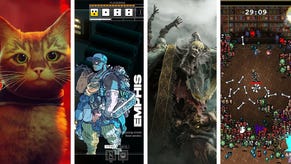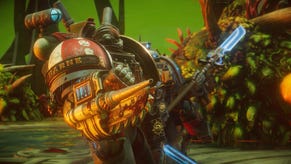Warhammer 40K: Chaos Gate - Daemonhunters looks like aggressive space XCOM and I’m here for it
A Bloomin’ good time
I was sold from the moment our Justicar sliced off the mutated Apostate Preacher’s tentacle arm. The poor thing was clutching a Vox Stave, and so removing his arm removed the use of his scariest abilities - although in this case the dismemberment proved academic, because it also left him exposed to immediate melee execution. That left our Interceptor free to shoot a nearby statue down on top of a cultist before stabbing him and his friend to death, which in turn gave our Apothecary enough space to chuck a grenade at a bridge and send three Poxwalkers plummeting to their doom.
I’m no Warhammermun. Those proper nouns are all cosmic Greek to me, but I’m relieved to report they didn't obscure the promise within the 30 minutes of Warhammer 40,000: Chaos Gate - Daemonhunters I was shown last week. This is fast-paced XCOM in space, with extensively destructible terrain, an intriguing dual focus on ranged and melee combat, and not a miss chance in sight. That should sound enticing to just about anyone.
You play as an initially small and battered band of Grey Knights, a secretive sect of space marines who constitute (at least to my ignorant space fantasy eyes) humanity’s ghostbusters. When a Chaos God comes romping out of the Warp, these are the chaps you call - and would you look at that, here’s one now! His name is Nurgle, and he’s brought some horrible plague-spreading plants called “the Bloom” that he’s just dying to show you.
In the mission I’m shown, the Knights are happy to oblige him. Skipping back to the start: our appropriately chunky boots hit the ground of an ancient cathedral, in search of a Bloom seed we can pinch for research. For now the scenery resembles your classic big ‘n’ spooky space temple, though we’re told that Bloom corruption can change the layout of cover and add new hazards, which we might have to contend with if the Bloom comes back to this planet later on.

Our Knights deploy exactly as you’d expect, drawing from individual pools of action points to move. One Knight sets up an overwatch cone, preparing to fire on anything that moves into it next turn. So far, so space XCOM - until some Plague Marines show up, and we get our first taste of Daemonhunter's intriguingly disambiguated combat. When you’re mulling over which enemy to shoot, you don’t see your chance to hit them. You are a big elite special space person, the reasoning goes, so hitting is a given. Instead you get to see exactly how much damage shooting from a certain distance and angle is going to do, which our Purgator demonstrates by moving close enough to turn a limp two into a cool three. I like the use of small, significant damage numbers, though I can only hope they stick around throughout the campaign.
The Knights haven’t just brought guns, of course. Another Plague Marine coats the surrounding area in toxic gunk, but our Justicar charges around it and stabs him. The charging is smooth and malleable, thanks to a waypoint placing system. The stabbing is brutal - yet not deadly, despite the use of a special ability that guarantees a crit. The next strike very much is deadly, thanks to the calculated deployment of a few willpower points. They’re a separate resource you’re encouraged to make liberal use of, seen as there are ways to regenerate them mid-mission. Wholescale slaughter, for the most part.
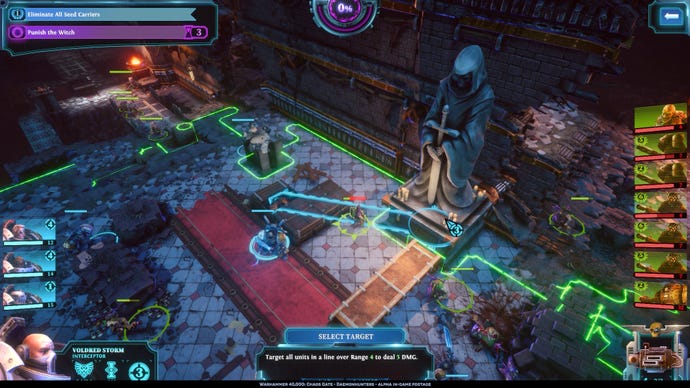
It all looks pleasingly energetic. I’ve plugged hundreds of hours into XCOM and its ilk, but I still shrivel up inside when turns become ponderous, with too many units taking too long to do too many things - so I asked creative director Noah Decter-Jackson exactly what they’re doing to avoid that.

“We’ve focused on giving players the tools to aggressively and efficiently deal with large numbers of enemies in a relatively small amount of turns”, he says, adding that the Knights can do massive damage over wide areas, with ample and generous use of certain abilities and combos. The goal is to “keep combat tight and quick so you’re not spending too much time pondering the exact and perfect decision”, with beefy health and armour pools on hand to mitigate a few mistakes. If the Knights get knocked down, they can get back up again with half their health, too. Big armoured space hunks, remember.
It’s easy for a short, carefully curated demo to convey a distorted impression of how a game will play in practice - but nonetheless, everything I saw lived up to Jackson’s description. They’ve landed on an agreeable philosophy where success begets success, exemplified by the way landing a critical hit opens the door to a further round of more brutal attacks. It’s that system that now let’s us chop that Preacher’s arm off. Splendid. Although, it is worth noting the de-limbing seems clearly the best option, with an otherwise measly choice between stunning him or inflicting a piddly bit of bleed damage. It’ll be a crying shame if this, Complex Games’ much touted “precision melee combat”, always boils down to clicking the same button, because in concept it’s a great way of flinging you from one interesting decision to the next.
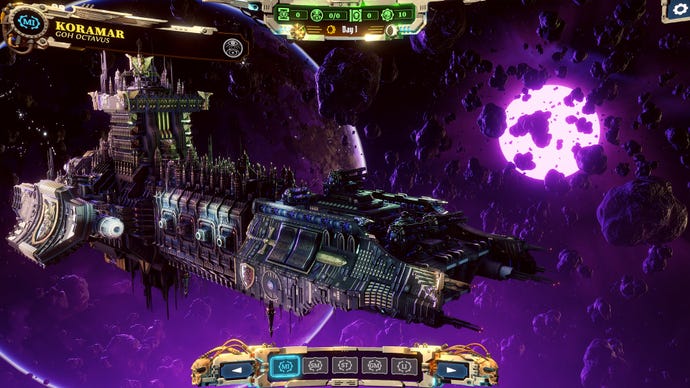
But enough of tactics. Let’s talk about the integration of the strategic layer, baby, let’s talk about you and me - and about how we’re flying around in an upgradable space warship (but be careful, baby, the hull is, like, super spiky). This part also looks extremely XCOM, right down to the timeline in the bottom left which tells you how many days it’ll be before you need to check in with your boss. Here you’ll find building and research projects, alongside familiar facilities for training and recruitment.
On top of those, though, are upgrades to the ship itself, with tantalising subsections for shields, guns, engines and more. Staying on top of all this could make for a compelling balancing act, especially seen as your engine speed affects how quickly you can reach missions on the star map. “You’re not going to be able to deal with them all”, says Jackson. Instead, it’ll be a case of pitting desirable mission rewards against convenience, while wrestling with a doomsday clock that, again, sounds a whole lot like the Avatar Project metre from XCOM 2.
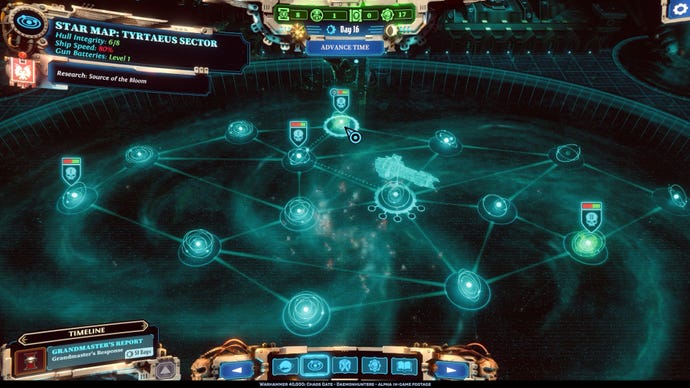
All these comparisons are no bad thing. XCOM built some great foundations, suitable for all manner of borrowing, improving, and boltings-on. I’m intrigued about the boss battles, for instance, which we’re told will present unique threats around hazardous, fight-defining terrain. They could be gimmicky, they could be cool. I can’t say, because our demo ends with a surprise attack from a nonetheless menacing Hellbrute. It takes the whole squad to bring him down, before he takes almost the whole squad out by exploding. Dealing with those is going to be a nightmare, I can tell.

In summary, yes, I like the look of Chaos Gate - Daemonhunters. It’s a promising blend of the familiar and the new. True, it sometimes talks in gobboldy gook, but there are enough people who enjoy the gobboldygook that I’m prepared to do a spot of de-gobbolding. (The allure of arcane specificity is no stranger to this Dotamun.) You’ll no doubt find other previews that cover the tabletop angle better, but I should briefly mention Complex Games were keen to stress the involvement of Games Workshop, which extends to their aim of replicating custom paint jobs. You can manually choose individual right and left pauldrons, to be fair. What more do you want?
It’s been too long since I sunk my teeth into a good XCOM-like. Between Chaos Gate, Marvel’s Midnight Suns and Tom Francis’s Tactical Breach Wizards, the future looks bright. And also full of space plague. Fab.






